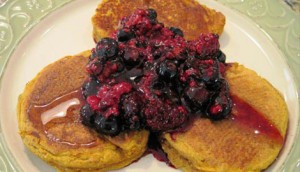As with most USRDA standards, the suggested 20-30 grams of daily fiber is a politically driven, lowest-common-denominator standard providing only enough fiber to minimize disease risk rather than promote abundant life. Since the Standard American Diet consists primarily of animal products, and fiber is exclusively found only in plant foods, it is no wonder that the average American consumes at most a meager 12 grams of this vital nutrient. Vegetables, fruits, legumes/beans, whole grains, fruits, nuts, and seeds—plant based foods—are the only sources of fiber.
Dr. Fuhrman, one of my greatest heroes in preventative nutrition, recommends that we aim towards eating nearly 80 grams of fiber daily. While this number may seem virtually unattainable, the great news is that simply by eating more plant based foods, you will not only likely surpass the meager suggestion of 20 grams of daily fiber, but also gain the chief benefits of eating the world’s most micronutrient rich foods. This means that by taking baby steps towards eating more fiber, you are also in turn getting the greatest bang for your buck by consuming foods for long-term disease prevention.
Micronutrients are best received through eating real, whole foods. The FDA has approved various synthetic sources of fiber such as polydextrose, resistant corn starch, cellulose, for human consumption in products such as Metamucil, Citrucel, FiberCon. While fiber can be isolated or developed synthetically, and then taken as a supplement or food product, do not waste your time with these low grade forms which are heavily processed and easily lose their fiber-rich qualities. Whole foods are, by design, intricately packaged to contain thousands of disease preventing phytochemicals, vitamins, minerals, and antioxidants. Check out my insights into whole foods sources of fiber below and reward every fiber of your being with wholesome goodness!
Leanne’s Insights to Whole Foods Sources of Fiber:
- Keep all fruit and veggie skins on—in applesauce, mashed potatoes, do not cut the crusts off your kid’s sandwich, etc. Often times the skins of produce contain more nutrients than the inner flesh anyway!
- Increase fiber gradually over a few weeks—adding too much fiber too quickly can trigger intestinal gas, abdominal bloating, and cramping. Your natural stomach bacteria in your digestive system will learn to adjust to the change by natural design.
- Go hearty with lentils—lentils are the leader of the pack for fiber in the beans/legumes category. This all-star, delicious legume is versatile and easily consumed in soups, atop salads, as a hummus dip, etc.
- Eat your juice—eat whole fruits and veggies instead of drinking them, as fibers are removed from juices.
- Take 2 Tbsp. ground flaxseed daily—not only do studies show that flaxseeds are loaded with anticancer compounds and contain 2400mg of omega-3 fatty acids but 2 Tbsp. of ground flax provides 4 grams of fiber.
- Blend green smoothies—this is my favorite way to boost daily fiber first thing in the morning. Not only can you easily toss in your 2 Tbsp. flaxseed but also include nutrient-rich, high fiber ingredients such as berries, dark leafy greens, and other additions without extracting the fibers as is done in juicing. I find that many individuals are able to drink a whole lot more greens when they are blended in a smoothie than they can chew in a huge salad.
- Load up on beans—a single cup of garbanzo beans provides 12.5 grams of wholesome fiber. From bean burritos and hummus spread to soups and dips, beans are a
 filling, budget friendly and delicious source of fiber.
filling, budget friendly and delicious source of fiber.
- Choose the Super 6—if you are gluten-intolerant, getting quality fiber through whole grains requires greater intentionality. There are 6 gluten-free grains coined “the super 6” because they are highest in vitamins and fiber. These are amaranth, buckwheat, millet, sorghum, teff, and quinoa. Although these are also nutritious for those who can digest gluten, if gluten agrees with you, be sure to also enjoy the vast array of gluten-containing grains available to us such as brown rice, steel cut oats, etc.
- Don’t overcook veggies/fruits—besides the fact that vegetables are most flavorful when cooked al dente (or just done), overcooking fruits and vegetables alters their fiber content. The same principal applies to pasta, which when overcooked, becomes higher glycemic.
- Increase your water intake—as you increase your fiber be sure to drink more water. Insoluble fiber needs water to keep our bowel movements regular. Fiber works best when it absorbs plenty of water, making stools soft and bulky for healthy elimination and detoxing.
- Increase plants, decrease animal foods—cheese, eggs, milk, meat, fish, and processed foods contain no fiber whatsoever. If these foods comprise the bulk of our diet we will naturally be deficient in fiber. Simply eat more plant based—nuts, seeds, vegetables, fruits, whole grains, beans/legumes and you will gain the benefits of fiber as well as all the additional benefits mentioned.
- Pop Some popcorn—yes, popcorn is a whole grain! Whip up my guilt-free recipe dusted with protein and fiber-rich nutritional yeast and gain the benefits of a new favorite, high-fiber snack.
For further reading, check out last week’s post on Fiber—the Colon’s Toothbrush.
CelebrateNutrition.com
https://www.facebook.com/CelebrateNutrition









